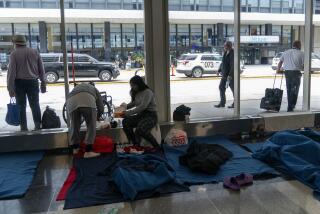Airlines to Limit O’Hare Flights
- Share via
WASHINGTON — Under the threat of federal regulation, several of the nation’s airlines have agreed on a plan to temporarily unclog the bottleneck on the runways at Chicago’s O’Hare International Airport, officials announced Wednesday.
From November to April, airlines at the nation’s busiest airport will cut the number of scheduled flights arriving during peak hours -- between 7 a.m. and 8 p.m. -- from about 95 to 88. Federal Aviation Administration officials estimate that by January, the hourly cap will reduce delays at O’Hare by 20%.
Delays at the airport have reached extraordinary lengths and record frequency this summer, causing backups on runways across the country. In June, 70% of flights left O’Hare on time, compared with 82% at airports nationwide. The FAA considers a flight delayed when it is 15 minutes or more off its published schedule; the average delay at O’Hare was an hour and 10 minutes, according to government figures.
“O’Hare no longer will be the place where on-time schedules go to die,” FAA Administrator Marion C. Blakey said Wednesday at a news conference at O’Hare.
As part of the deal, the airport’s two largest carriers agreed to reduce their schedules by about 5%. American Airlines will remove 17 flights between noon and 8 p.m., and United Airlines, which uses O’Hare as its main hub, will cut 20 flights.
Smaller carriers also agreed to limit their peak-hour schedules. Airlines with no more than eight arrivals a day will not be able to add more than one arrival between noon and 9 p.m.
All airlines agreed to seek FAA approval before rescheduling flights.
This month, Transportation Secretary Norman Y. Mineta called representatives from 16 airlines to Washington to draw attention to the mounting delays and put pressure on the carriers to voluntarily reduce flights. Mineta threatened to impose a limit of 86 arrivals an hour.
After two days of closed-door meetings, airline representatives flew home without reaching a deal, but continued negotiations.
Experts said the agreement announced Wednesday would immediately help alleviate congestion, but could also have long-term effects on competition at O’Hare.
“This gets the government back in the business of controlling access,” said Joseph P. Schwieterman, a transportation expert at DePaul University in Chicago. In 2002, the FAA phased out its effort to control traffic at O’Hare by assigning landing slots to airlines.
Schwieterman said the agreement may force airlines wanting access to O’Hare runways to lobby Congress and the White House. It might also lock out airlines that did not participate in the negotiations.
“This freezes O’Hare at its current competitive configuration, and that really prevents low-cost carriers from making inroads into the one of the nation’s biggest markets,” Schwieterman said.
“This is livable for one season, but you can’t live with those kind of restrictions when you compete with some who probably have two, three or five times more flights than you do,” said Ed Faberman, executive director of the Air Carrier Assn. of America, a trade group that represents small carriers.
Representatives of larger carriers also said the agreement was a short-term fix. “The long-term solution is more concrete, more runways,” said Mary Frances Fagan, spokeswoman for American Airlines.
United and American support a plan to update O’Hare’s infrastructure by realigning runways. The plan is undergoing environmental assessment and is awaiting FAA approval. Chicago Department of Aviation officials say the earliest the new runways could open is September 2007.
More to Read
Inside the business of entertainment
The Wide Shot brings you news, analysis and insights on everything from streaming wars to production — and what it all means for the future.
You may occasionally receive promotional content from the Los Angeles Times.











